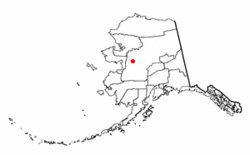Koyukuk, Alaska facts for kids
Quick facts for kids
Koyukuk
Meneelghaadze’ T’oh
|
|
|---|---|

Location of Koyukuk, Alaska
|
|
| Country | United States |
| State | Alaska |
| Census Area | Yukon-Koyukuk |
| Incorporated | September 25, 1973 |
| Area | |
| • Total | 5.85 sq mi (15.15 km2) |
| • Land | 5.75 sq mi (14.88 km2) |
| • Water | 0.10 sq mi (0.27 km2) |
| Elevation | 118 ft (36 m) |
| Population
(2020)
|
|
| • Total | 98 |
| • Density | 17.06/sq mi (6.59/km2) |
| Time zone | UTC-9 (Alaska (AKST)) |
| • Summer (DST) | UTC-8 (AKDT) |
| ZIP code |
99754
|
| Area code | 907 |
| FIPS code | 02-42050 |
| GNIS feature ID | 1404984 |
Koyukuk is a small city in Alaska, United States. Its name in the Koyukon is Meneelghaadze’ T’oh. In 2020, about 98 people lived there.
Koyukuk is located in the Yukon-Koyukuk Census Area, Alaska. It's a very small community. Like some other places in Alaska, Koyukuk faces challenges from erosion, which means the land is slowly wearing away.
Contents
History of Koyukuk
The Koyukuk area has a rich history. Long ago, the Athabascan people, specifically the Koyukon group, lived here. They were nomads, meaning they moved around. They followed wild animals and set up seasonal camps.
They had about 12 summer fishing camps along the Yukon River. These camps were between the Koyukuk River and the Nowitna River. The Koyukon people also traded with the Inupiat from the Kobuk River area. This trading happened even before Europeans arrived.
After the Alaska Purchase in 1867, the United States took control of Alaska. A military telegraph line was built along the Yukon River. Koyukuk became a telegraph station, which was important for sending messages.
Around 1880, a trading post opened in Koyukuk. This was just before the big gold rush of 1884–85. Many people came looking for gold. Steamboats traveled on the Yukon River to supply these gold prospectors. In 1900, which was a very busy year, 46 steamboats were operating on the river.
However, 1900 also brought difficulties. A measles sickness spread, and there wasn't enough food. This caused the population in the area to drop by one-third.
The first school in Koyukuk was built in 1939. After the school opened, families started to live in Koyukuk all year round instead of moving seasonally.
In 2015, Koyukuk was used as a checkpoint for the famous Iditarod Trail Sled Dog Race. This happened when the race route was changed from Fairbanks.
Geography and Location
Koyukuk is located in a beautiful part of Alaska. It sits right on the Yukon River, close to where the Koyukuk River flows into it.
The city is about 50 kilometers (31 miles) west of Galena. It is also very close to two large protected areas: the Koyukuk National Wildlife Refuge and the Innoko National Wildlife Refuge. These refuges are special places for wildlife.
The city covers a total area of about 15.15 square kilometers (5.85 square miles). Most of this area, about 14.88 square kilometers (5.75 square miles), is land. A small part, about 0.27 square kilometers (0.10 square miles), is water.
Population and People
The number of people living in Koyukuk has changed over time. Here's a look at the population from different years:
| Historical population | |||
|---|---|---|---|
| Census | Pop. | %± | |
| 1880 | 150 | — | |
| 1890 | 174 | 16.0% | |
| 1910 | 121 | — | |
| 1920 | 124 | 2.5% | |
| 1930 | 143 | 15.3% | |
| 1940 | 106 | −25.9% | |
| 1950 | 79 | −25.5% | |
| 1960 | 128 | 62.0% | |
| 1970 | 124 | −3.1% | |
| 1980 | 98 | −21.0% | |
| 1990 | 126 | 28.6% | |
| 2000 | 101 | −19.8% | |
| 2010 | 96 | −5.0% | |
| 2020 | 98 | 2.1% | |
| U.S. Decennial Census | |||
Koyukuk first appeared in the U.S. Census in 1880. It was called "Koyukuk Settlements" back then. In 1890, it was listed as "Koyukuk River Settlements." After that, it didn't show up again until 1910, when it was simply called Koyukuk. The city officially became an incorporated city in 1973.
In 2000, there were 101 people living in Koyukuk. Most of the people living there, about 91%, were Native American. About 9% were White.
There were 39 households in the city. A household is a group of people living together. About 41% of these households had children under 18 living with them. The average household had about 2.59 people.
The population of Koyukuk is quite young. In 2000, about 34.7% of the people were under 18 years old. The average age of people in Koyukuk was 30 years.
The median income for a household in the city was $19,375. This means that half of the households earned more than this amount, and half earned less. About 35.1% of the people in Koyukuk lived below the poverty line. This includes about 53.8% of children under 18.
Education in Koyukuk
Children in Koyukuk attend the Ella B. Vernetti School. This school is part of the Yukon–Koyukuk School District.
Notable People
- George Attla (1933–2015) was a famous sprint dog musher. He was born in Koyukuk and became a champion in the sport.
See also
 In Spanish: Koyukuk (Alaska) para niños
In Spanish: Koyukuk (Alaska) para niños

